When you started selling on Amazon, doing SEO probably wasn’t the first thing that you thought about.
Chances are you added the products, descriptions, ran some ad campaigns, and… That’s pretty much it.
This was enough five years ago, but now, with over 8 million sellers on the platform, Amazon has become a go-to destination for online product search.
Where there’s demand, there’s also fierce competition.
Amazon works like Google in many ways – for one, it has its own search algorithm, the A9 – so you need to do some SEO to show up higher in search results.
Here are the top ten dos of eCommerce product page SEO for Amazon sellers.
- 1. Learn How A9 Ranks Product Pages
- 2. Optimize the Listing with Relevant Keywords
- 3. Compare Your Prices and Terms with Competitors
- 4. Boost Your Seller Metrics with More Positive Customer Reviews
- 5. Optimize Listing Images
- 6. Optimize the Product Title
- 7. Write Product Characteristics as Benefits for Customers
- 8. Include A+ Content
- 9. Answer Customer Questions in the Q&A Section
- 10: Regular A/B Testing
1. Do: Learn How A9 Ranks Product Pages
Optimizing something without knowing the requirements is pointless, so you need to spend some time learning about Amazon’s A9 search system.
No worries, it’s not that hard. Plus, you need just a basic understanding.
So, like Google, Amazon uses a special algorithm to define a listing’s position in the search results.
There are several signals used by A9 to search for and rank listings:
- keyword optimization. The listing must feature relevant keywords
- sales conversions. A low conversion rate might negatively impact the ranking of the listing
- product authority. This is based on customer feedback showing customer experience with the product.
These signals are the most important ones when it comes to product ranking. As you can see, it all really comes to being relevant, reliable, and having the right keywords.
Now, let’s talk about each of these in more detail.
2. Do: Optimize the Listing with Relevant Keywords
When a customer searches for a product with certain keywords, A9 matches the keywords against the copy you wrote on the product pages.
According to Amazon Seller Central, you need to ensure the relevance and completeness of product information to get picked up by the algorithm.
In this context, relevance means describing the product in an appropriate way, which includes the value to the customers.
The completeness of the product information means including all important details that the customer might consider to choose the right item.
So, you need to choose the keywords carefully to increase a page’s visibility and sales.
With that in mind, let’s now see how you should find the best keywords to optimize your product pages.
A great way to find them is to use the Autofill feature on Amazon.
Let’s suppose you’re selling dog leashes. Start the search with words that describe your product and you’ll see good options.
The fact that Amazon gives you these keywords means that they’re used by customers. This makes them relevant.
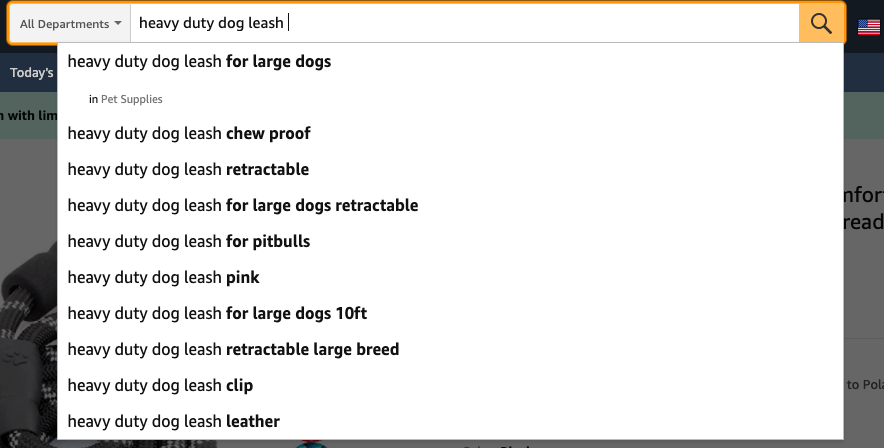
As you can see, one search like this could give you at least a few nice keyword ideas to use in the product title and description:
- retractable
- heavy duty
- leather
- for pitbulls
- for large dogs
- chew proof
- pink
- clip
Let’s continue our search for “heavy-duty dog leash.”
If we visit one of the top results, we’ll see that both the title and the description include some of these keywords.
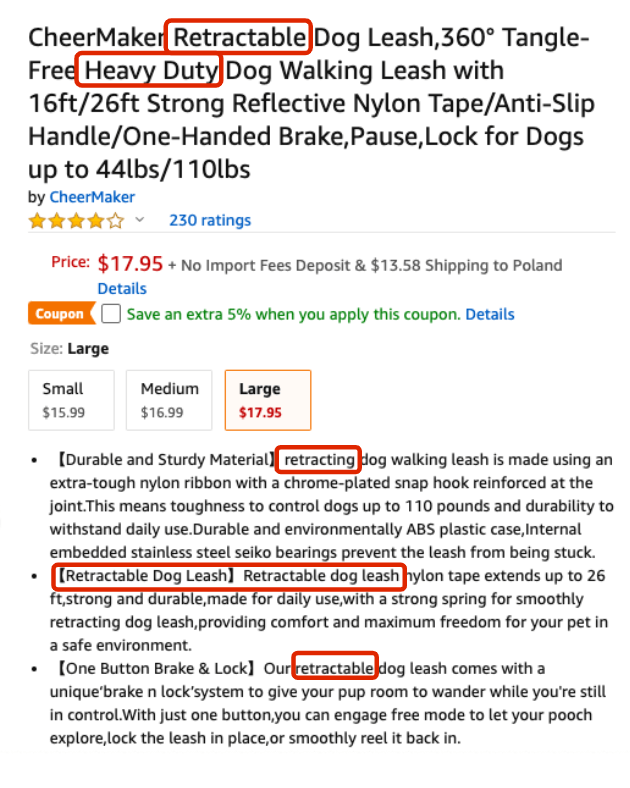
To optimize your product title and description with keywords, do your research and make a list of features and characteristics that people use to find your product.
Dive Deeper: How to do Amazon Keyword Research: The Ultimate Guide.
3. Do: Compare Your Prices and Terms with Competitors
While this tactic doesn’t sound like something directly related to SEO, it actually has a profound effect on it.
As mentioned, the conversion rate is one of the SEO signals the A9 uses, so you need to look for ways to increase your Amazon conversion rate.
Besides, the platform knows about your return rate, so it helps them define how satisfied your customers are with the experience you provide.
Here are some good ideas to start:
- price optimization. Ensure that your prices aren’t significantly higher than those of competitors’
- shipping/return policy optimization. The policies on shipping and returns impact the decision of buyers, so make them customer-friendly by minimizing delivery times and providing reasonable and simple return conditions.
The latest research says that shipping, returns, and prices play are among the top reasons to shop on Amazon in 2020.
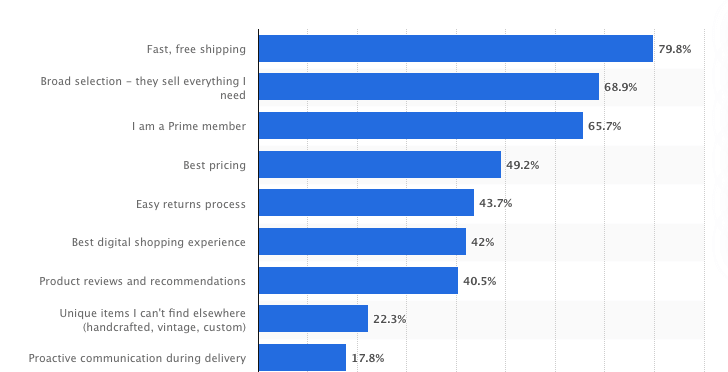
So, the policy changes you make might encourage more customers to buy, thereby increasing your conversion rate and reputation.
4. Do: Boost Your Seller Metrics with More Positive Customer Reviews
If you take one more look at the top reasons to buy on Amazon this year, you’ll see that over 40 percent of customers value product reviews and recommendations.
That’s why building your seller reputation is a critical requirement that has a major impact on Amazon SEO.
You can get more positive reviews in several ways:
- provide a great customer experience. This is the single most important thing to do to build seller and products’ reputation.
- encourage happy customers to leave reviews after they bought your products.
- use an Amazon review tool to collect more reviews. You can send emails to customers asking to share their shopping experience and manage reviews in one place with a review request tool like AMZFinder.
AMZFinder is a powerful review management tool that can help you request more positive reviews from buyers, also monitors your existing reviews, and keep you stay with what people said about your products. Try it now with its 30-day free trial.
Dive Deeper: 11 Proven Strategies on How To Get Amazon Reviews in 2020.
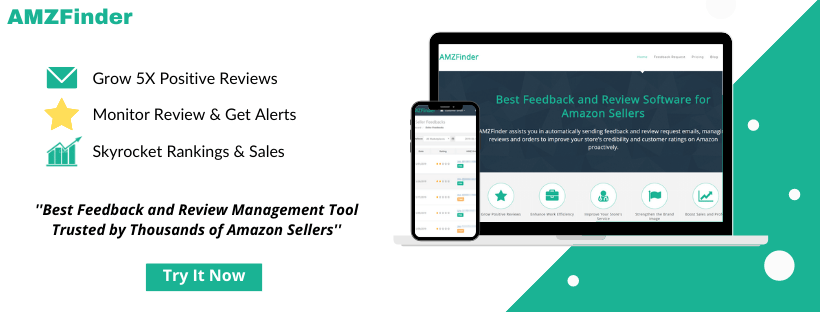
5. Do: Optimize Listing Images
Amazon imposes very strict requirements for visuals in product pages, and for a good reason.
Not only the visuals impact the loading speed of the product page but they also help with product research. This means they influence visibility and conversion.
Make sure to follow the platform’s product image guidelines:
- use accepted formats like .jpg, .tif, or .gif
- use images at least 1,000 pixels on the longest side to allow customers to zoom in
- include products on white background for better viewing experience
- show a product in use if possible.
Dive Deeper: The Complete Guide to Amazon Photo Requirements 2020.
6. Do: Optimize the Product Title
The product title is the most important element of the listing. You need to optimize it first to have the best chance to get to the top results.
Let’s search Amazon for “Running shoes for men” and see the best-performing titles.
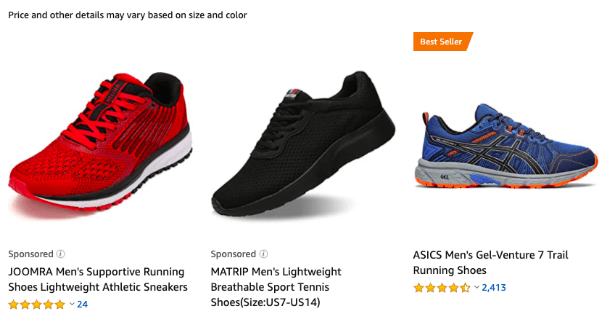
Here’s how you can improve the ability of a product title to rank, based on these results:
- include the name of your brand first. The titles above have them written in all caps
- add a brief description of the product, e.g. “men’s supporting running shoes” (important: should be based on keyword research!)
- include some product characteristics, e.g. “lightweight,” “athletic sneakers.” (important: should be based on keyword research!)
- clarify the product’s size, e.g. “size: US7-US14.”
Make all of these parts sound naturally together to avoid keyword stuffing.
Also, remember that there’s a title limit of 150-200 characters, depending on the product category.
7. Do: Write Product Characteristics as Benefits for Customers
This is a great way to attract attention and improve the ability of product descriptions to be more engaging.
Instead of making a list of product features, describe them from the point of view of the typical customer.
Let’s demonstrate.
Which of the following product descriptions do you like better?
The first one is focused on the product’s features (running shoes):
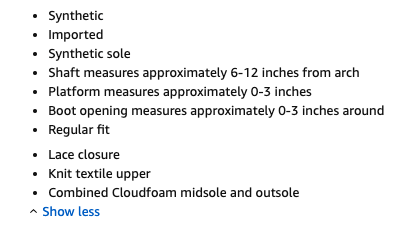
Okay, so it’s a list with the essential features.
What do you think of this next one (also a description of running shoes)?
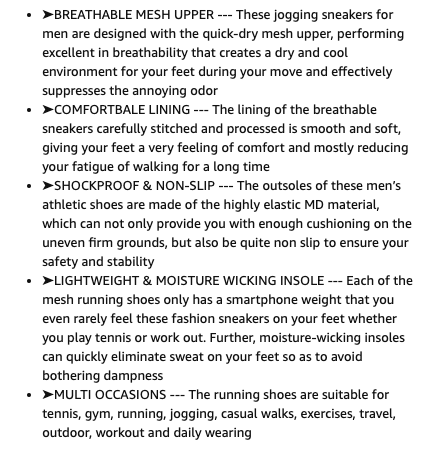
So, you verdict: which one can help you more with making a better choice of running shoes?
Most of the customers would choose the second one.
It describes:
- the performance of the shoes in specific environments
- the situations and use cases suitable for the product
- how the shoes should feel on feet
- how they reduce fatigue.
The first one, on the other hand, misses all this info, so it has less value for customers.
8. Do: Include A+ Content
Let’s make one thing clear: A9 algorithm doesn’t evaluate A+ content as a ranking factor.
Still, you need to optimize it.
The reason why A+ content is important for SEO is simple: it provides a better shopping experience for customers.
The better the experience is, the more likely someone is to buy. In turn, this means a higher seller and product authority.
Here are A+ content best practices for SEO:
- follow Amazon’s resolution and size recommendations. They’re different depending on product category but very important to provide the best shopping experience
- don’t include hyperlinks. They will be rejected because the images can’t contain them
- proofread the copy thoroughly. Use online proofreading tools like Grammarly or Trustmypaper to avoid having spelling mistakes being displayed at product pages in images.
Dive Deeper: Complete Guide for Amazon A+ Content: How to Create an Amazing Page.
9. Do: Answer Customer Questions in the Q&A Section
As we know, Amazon tracks various aspects of customer experience to define your rating.
One important aspect of that experience is how fast and effectively your customers can get answers to questions related to your products.
To earn a reputation of a reliable and helpful seller, you need to be able to provide accurate and helpful answers.
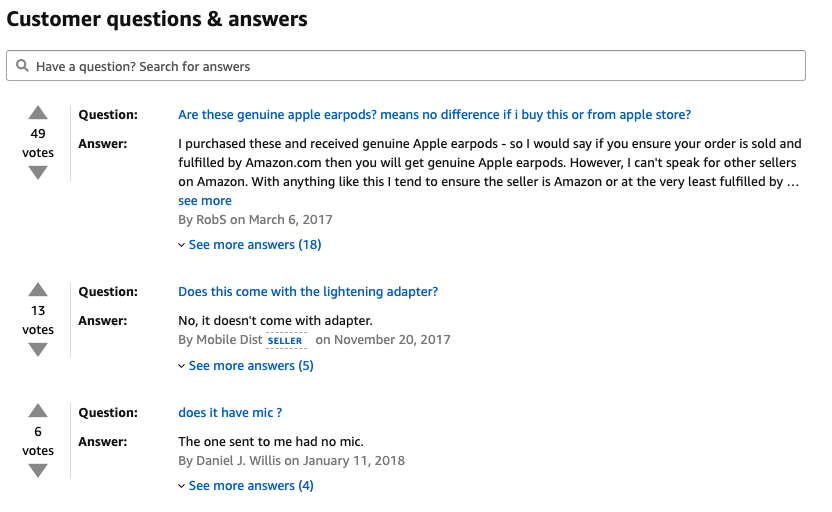
So, monitor the Q&A section at product pages for new questions from customers.
By doing so, you can help customers to get more information and include more search terms and important product details to improve the page’s ranking.
10: Do: Regular A/B Testing
There’s no universal formula when it comes to doing Amazon SEO, so you need to test everything you put out there, including:
- product descriptions
- product titles
- A+ content versions
- pricing rates.
An effective Amazon A/B testing can help to find the versions of listings that have the most visits, conversions, therefore, are optimized best.
Amazon Product Page SEO: a Quick Recap
Don’t do these SEO tips right, and Amazon’s algorithm will prioritize the products of competitors over yours.
Just like with Google SEO, it’s really important to cover all bases to have the best chance at beating competitors to the top (of search results, that is).
Hopefully, this list of the best practices served you as a nice checklist for Amazon SEO.
You may also like:
Amazon SEO: How To Rank Your Products To Top One on Amazon
Comprehensive Guide to Amazon SEO: Optimize Amazon Listings
12 Amazon Keywords Research and SEO Tips That Sellers Should Never Miss
The Complete Guide to Amazon Search Term Optimization
Best Amazon Listing Optimization Complete Guide 2020
AUTHOR BIO
Nicole Garrison has been actively involved in content writing and copywriting since 2012, working in content marketing, online advertising, and social media marketing areas. Currently, she works as a senior content writer at thesis writing service and ClassyEssay. Nicole is a regular participant at international content writing conferences and writes opinion pieces and case studies on blogging for business.

Leave a Reply
You must be logged in to post a comment.